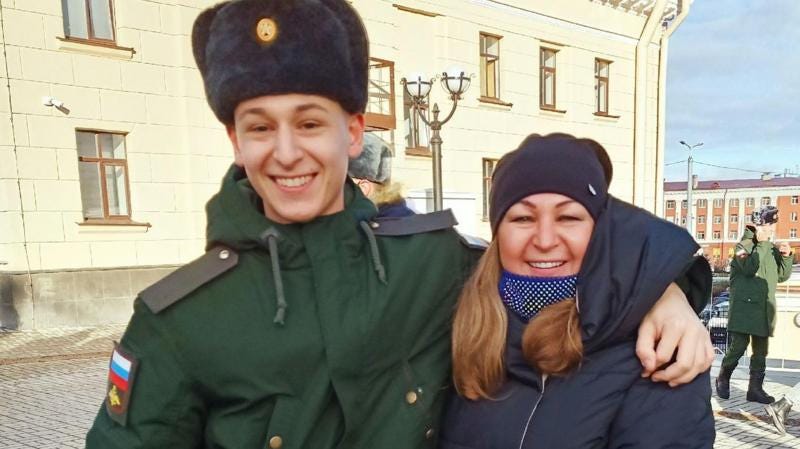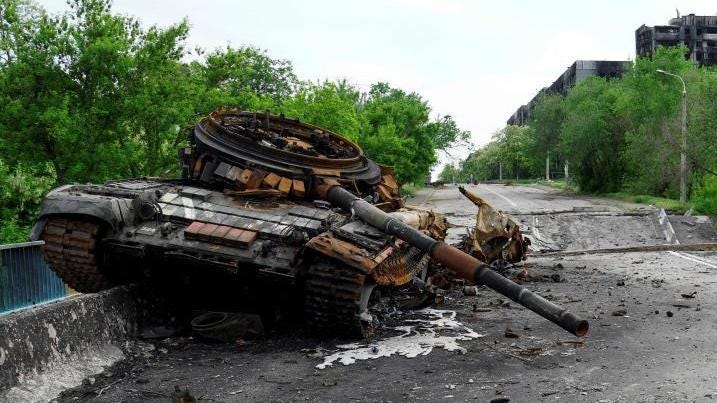50 thousand confirmed killed. What we can say about Russia's losses in Ukraine to date
By April this year, the true number of war dead may have reached almost 125,000.
By Olga Ivshina.

“’Praise be to You, O Lord!’ I burst out... and then there was emptiness and darkness. After that, there was silence. When I came round to myself, it was with wild wailing and sobbing,” wrote Irina Chistyakova on her social media page.
“This is how on March 20th, 2024, I received the news of death, and the DNA match, of my darling Kirill, the son I suffered and had begged God for.”
Kirill was 19 years of age when he went missing after a battle in Kharkiv region back in March 2022. Like some other relatives of Russian soldiers, his mother had to wait two years to find out what happened to him.
With official statements on casualties a rarity, the BBC, the Mediazona news outlet, and a team of volunteers have been working together to keep track of the number of Russian soldiers killed at the front. By our calculations, at least 43% of them were not associated with the army when Russia invaded Ukraine. The real proportion of erstwhile civilians may be as high as 70% of combat losses.
Kirill Chistyakov was drafted in Karelia, in north-western Russia before, to his family’s surprise, he signed a contract just before the full-scale invasion was launched. His mother believes he was forced to do so. Kirill went missing in one of the very first battles of the war, but his remains were only discovered last month.
Despite Vladimir Putin’s promises, conscript soldiers are still taking part in combat operations. We know the names of at least 101 conscripts who have been killed in the course of the invasion. Some died guarding the border in Belgorod region, and do not officially count as combatants. But in essence, yesterday’s schoolboys were facing almost daily artillery fire and small arms attacks while holding positions that ought to have been guarded by professional soldiers.
Currently, 18% of all confirmed losses are ex-prisoners, 13% volunteered for the front, and 12% were conscripted. Another 28% of the dead could not be determined to belong to any specific group of servicemen or branch of the military.
In the first place, this is because the Russian authorities are now providing far less detail about casualties than they did at the start of the war. In the majority of such cases, obituaries are illustrated with photographs of the deceased wearing civilian clothes.
This allows us to assume that the majority of those gathered in our ‘no data’ category had no military association before the full-scale invasion of Ukraine got underway. By the same token, the actual number of those who left for the front as former civilians may be as high as 70% of all Russian combat losses.
The figures mentioned here only account for losses we have been able to establish through open sources: statements from officials, or in the media; social media posts by close relatives of the dead; and information from memorials and burial sites.
The true number of Russian casualties, not counting the dead from the so-called ‘people’s republics’ of the Donbas, could be two times higher, according to our estimates. We reached this conclusion by systematically examining what is happening in cemeteries in 70 locations across Russia.
Russian casualties in detail
Confirmed weekly losses began to rise steeply from early October last year, reaching 550-600 men. The average in August and September had been in the region of 360 a week. The surge coincides with the start of the operation to finally take Avdiivka, for which fighting had raged since February 2022, and other population centres in the Donetsk region.
From October to April this year, at least 10,014 military personnel have been killed on the Russian side, excluding those whose date of death is unknown.
Many experts believe that Russian attempts to effect a breakthrough in the Donetsk region have now been halted. But news of the dead arrives with delay, so we are still getting reports about those killed during the offensive, and the storming of Avdiivka in particular.
Overall, autumn-winter losses in 2023 are only rivalled by those suffered during the capture of Vuhledar and Bahmut in the winter of 2022 and spring of last year. The rate of increase in losses is still running at 1.5-2 times higher than the average at the start of the invasion.
Main Trends
Contrary to earlier expert predictions, prisoner battalions continue to play a big role at the front and are still incurring high losses. The main reason for this is the army is continuing the tactics used by the Wagner Group private military company (PMC). These involve waves of attacks by small assault groups at different points on the frontline. The method leads to heavy losses of men.
The defence ministry is using a range of strategies to replenish the ranks of combat units. First, they continue to recruit from convicts in penal colonies. The difference now is that they are not discharged after six months fighting but have to stay in the ranks to the end of the war.
The second strategy is to encourage volunteers to sign up with the army. Even last year, local civil servants talked of a plan ‘sent from above’ for recruitment and dispatching freshly-minted contract soldiers to the front.
The city of Krasnoyarsk in Siberia offers an example: authorities there were tasked with signing up 2,000 men. “Each district gets a plan. That plan has been drawn up for the whole of 2024,” said Yuri Savchuk, the head of one of the city’s districts. “There are two pages. One shows how much has been completed from the plan to date. and as of today, we have a shortfall for February: we are down two people.”
A local MP, Vyacheslav Dyukov, tried to encourage him: “Over the past year, it is mostly alcoholics, the homeless, weirdos and convicts who have become contract soldiers. The Central and Railway districts are old, and there are just fewer people of that sort here than in the outskirts of the city.”
Those paratroopers or special forces soldiers who survived the start of the war are being conserved by the military command, who deploy them now to hold positions or for sniper operations. Costly specialists are only sent into attacks if the conditions are favourable.
As for officers, Russia has lost at least 3,354 in Ukraine. The number includes 1016 elite specialist troops, including airborne forces, the marines, special forces, national guard special units and military pilots.
The loss of such officers is felt hardest by the Russian army — because they are the hardest to backfill. A killed special forces company officer, for example, can only be replaced by an officer of the same military specialisation. That means a minimum of four years’ military academy plus another two or three years of service to gain the right experience.
On top of that, the structure of the Russian armed forces means that typically only officers are trained to work in sync with other branches of the military, especially the artillery. Entrusting such work to untrained or inexperience commanders in high pressure situations can lead to a lack of coordination and greater losses on the ground.
It is exactly this inability to coordinate and conduct complex offensive manoeuvres that constitutes the main reason why the Russian advance in the Donbas has ground to a halt, according to experts we have interviewed.
A general evaluation of Russian casualties
The total figure for losses among Russian troops rises significantly if we include those who were fighting against Ukraine as part of the ‘people's militias’ of the self-proclaimed Donetsk and Luhansk People's Republics (DNR and LNR).
The DNR stopped publishing casualty data in December 2022, while the LNR authorities never made them known in the first place. But by studying obituaries or reports about searches for soldiers missing in action, we can conclude that by the close of February, around 23,400 fighters from the Donbas ‘people’s republics’ had been killed.
Since we rely exclusively on open source information, we assume that we are only accounting for about a half of the real losses among Russian units. That means the actual number of dead may exceed 100,000. Adding the losses from the DNR and LNR would bring pro-Russian casualties to 123,400 men.
Мethodology
New names of the dead, along with photos from funerals, are published in Russia every day. Most often, their surnames are listed by the heads of Russian regions or district administration officials, local media, the educational institutions where the dead men studied, or by relatives.
The BBC, Mediazona, and a team of volunteers study the information and add it to a database we have been compiling since the full-scale war began.
A death is considered confirmed if published by an official Russian source or state media, by the soldier’s relatives, or by publication in other sources if accompanied with a burial photograph.
The main count does not include losses from the Donbas ‘people’s republics’, unless a Russian citizen volunteers himself to fight among their armed forces.
The branch of military in which the dead soldier served is established by his military district or uniform insignia. While conscripts, volunteers and prisoners do not constitute separate service branches, we highlight them separately in order to compare them with professional army units.
The ‘other branches’ categorisation in our chart refers to personnel from air defence, NBC protection troops, the signal corps, medics, aerospace forces ground staff, interior ministry troops, motorised and railway troops, and the military police.
BBC is blocked in Russia. We’ve attached the story in Russian as a pdf file for readers there.
Read this story in Russian here.
English version edited by Chris Booth.
Previously…
Counting Russia's dead in Ukraine. More than 45,000 confirmed killed
What we can say about Russia's military losses in Ukraine after two years of war. The total number of dead may be close to 115,000.









